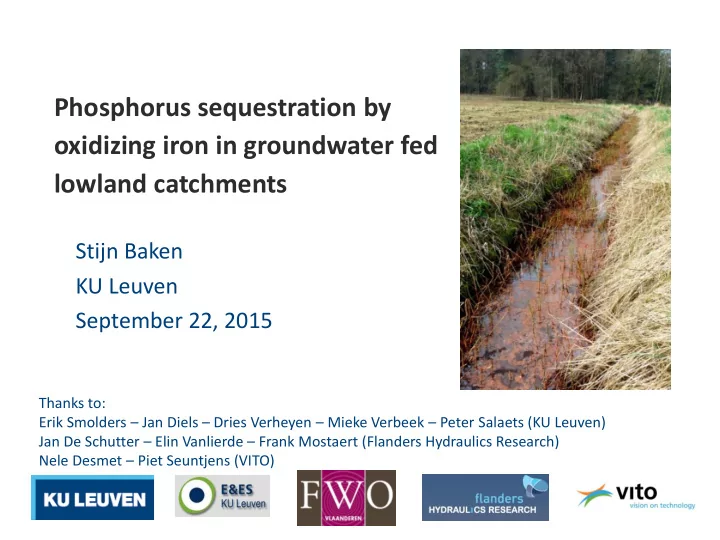

Phosphorus sequestration by oxidizing iron in groundwater fed lowland catchments Stijn Baken KU Leuven September 22, 2015 Thanks to: Erik Smolders – Jan Diels – Dries Verheyen – Mieke Verbeek – Peter Salaets (KU Leuven) Jan De Schutter – Elin Vanlierde – Frank Mostaert (Flanders Hydraulics Research) Nele Desmet – Piet Seuntjens (VITO)
Oxidation of Fe-rich groundwater → Fe oxyhydroxide particles JUST AFTER SAMPLING 2 DAYS LATER Reduced Oxidized Fe(II) Fe(III) (soluble) (insoluble) 𝐺𝑓 2+ + 3𝐼 2 𝑃 → 𝐺𝑓(𝑃𝐼) 3 +3𝐼 + + 𝑓 − • Oxidation rate at circumneutral pH: hours…days • In the presence of PO 4 First, Fe hydroxyphosphate formation until near depletion of PO 4 o Then, continued formation of Fe oxyhydroxides o
The P bound to Fe oxyhydroxides is poorly available to algae Algal growth and P uptake is reduced by adding Fe oxyhydroxide colloids. After time, part of the P slowly becomes available.
What if Fe-rich groundwater surfaces across a large area?
STUDY AREA • Groundwater fed lowland catchments • Flat topography, shallow phreatic aquifers • Underground: permeable marine deposits, some rich in glauconite • Average shallow groundwater composition: 20 mg Fe/L; 0.4 mg P/L o Fe source: glauconite weathering o P sources: geogenic, leaching from agricultural land
700 km 2 300 km 2
µS/cm mg/L Composition of filtered groundwater and surface water mg/L mg/L µg/L
The Fe(II) is oxidized and removed from solution (<0.45 µm) as the groundwater surfaces and flows through the catchment into increasingly larger streams
Before the water reaches the headwater streams, 90% of the P is removed from the <0.45 µm fraction
Drainage ditches with Fe-rich sediments seasonally evacuate groundwater
What happens as Fe and P bearing groundwater flows through Fe- rich sediments and into drainage ditches?
• As groundwater surfaces and flows through the catchment, the Fe is oxidized and Fe oxyhydroxide particles and colloids are produced. • These particles strongly bind P, and thereby remove it from solution • This study area is extreme in terms of its low P:Fe ratio o to what extent does this process occur in other lowlands?
Recommend
More recommend